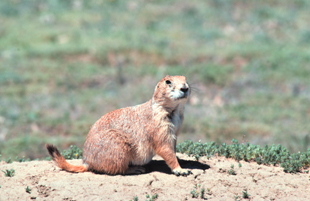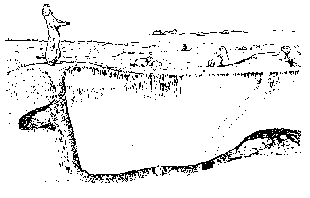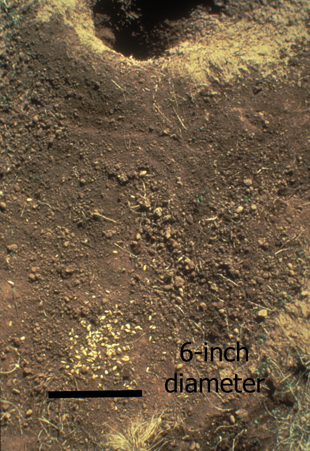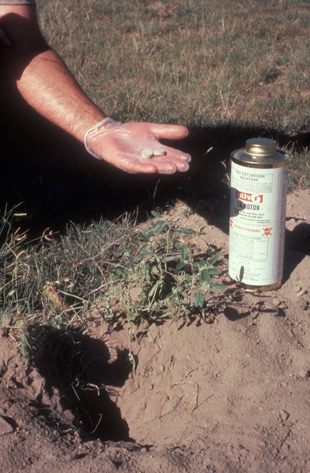G2101
Prairie Dogs and Their Control
Prairie dogs are an important part of the prairie landscape, but the damage they cause can be extensive. The control methods described can prevent or reduce damage.
Scott E. Hygnstrom, Extension Wildlife Specialist
Stephen M. Vantassel, Extension Program Coordinator—Wildlife Damage Management Distance Education
Timothy B. Veenendaal, Director, USDA-APHIS—Wildlife Services—Nebraska
- Ecological Importance
- Economic Importance
- Legal Status of the Black-tailed Prairie Dog
- Prevention and Control of Damage
- Evaluating Effectiveness of Control Methods
- Other Techniques
- Assistance
Black-tailed prairie dogs (Figure 1) are stocky, burrowing rodents that are members of the squirrel family. They are the only species of prairie dog native to Nebraska and they inhabit the western two-thirds of the state. Prairie dogs live in colonies called “dog towns.” They are interesting creatures to watch and are an important part of the prairie environment. They cause problems, however, when they conflict with livestock ranching and other land uses, or threaten human health and safety.
Black-tailed prairie dogs have tawny fur, large eyes, short legs, inconspicuous ears, and a characteristic black-tipped tail. Adults weigh 2 to 3 pounds and are 10 to 12 inches long.
Prairie dogs live in burrows that usually are about 6 to 9 feet deep and 20 feet long. Most burrows have one or two entrances and the associated mound serves as a sentinel post for the vigilant occupant (Figure 2). Prairie dog towns usually contain 30 to 75 burrows per acre, and numbers of prairie dogs vary from 1 to 50 or more per acre depending on location, food availability, and time of year. Prairie dog towns in Nebraska range from one to several hundred acres and may contain from a few to thousands of individuals.
 |
 |
|
| Figure 1. Black-tailed prairie dogs, Cynomys ludovicianus. (Photo by Stephen M. Vantassel.) | Figure 2. Prairie dog burrow showing raised mounds, tunnels, and nest areas. |
Prairie dogs inhabit most soil types but are less likely to occur in sandy or heavy clay soils. Prairie dogs do not thrive in eastern tallgrass prairie unless it has been heavily grazed. Colonies in the more western mixed and short-grass prairie usually begin and remain near where concentrated grazing by livestock occurs.
Prairie dog towns consist of social groups called “coteries” that typically contain 1 or 2 adult males, up to 6 adult females, and several yearlings and juveniles. Almost all mating occurs among unrelated individuals within a coterie. Black-tailed prairie dogs mature in 1 year, but most don’t breed until they are over 1½ years old. One breeding season occurs per year in February and March, and litters of 3 to 6 pups are born in March or April. The pups first emerge from their burrows at about 6 weeks of age during May, just before weaning.
Males usually leave the coterie as yearlings in the early summer of the following year. Prairie dogs often travel several miles to establish new colonies or burrows at the edges of other existing colonies. Prairie dogs readily adapt to areas close to humans and livestock. They are active during the day and remain somewhat active during the winter.
Prairie dogs are opportunistic feeders, eating many different kinds of grasses, sedges, and broad-leaved plants. They switch their diet to include more seeds and roots during fall and winter. Prairie dogs have the ability to go without food for long periods of time and fulfill their need for water entirely through plants in their diet.
Prairie dogs use several forms of communication including a “kiss” of recognition, where two touch their front teeth. Either amicable grooming or chasing and fighting may ensue, depending on whether the animals are competing for mates or nest sites or protecting their young. Prairie dogs often sit upright at the openings of their burrows, with heads held high to watch and listen for threats of danger from predators. If spotted, a series of barks by the sentinels can send the occupants of the whole colony underground.
Ecological Importance
Immense colonies of prairie dogs were present on the Great Plains before settlement. Although significantly reduced, these colonies still create unique patches of habitat in extensive grasslands. These patches are used by an abundance of wild creatures, such as burrowing owls, ferruginous hawks, mountain plovers, and horned larks. Over 200 species of wildlife have been associated with prairie dog towns. Prairie dogs are prey for a variety of predators such as hawks, eagles, badgers, coyotes, foxes, and weasels.
One special animal that is dependent on prairie dogs is the black-footed ferret. It is a member of the weasel family, lives in prairie dog towns, and feeds almost exclusively on prairie dogs. Because of habitat loss (prairie dog towns), black-footed ferrets are very rare and are included on the federal list of endangered species. Before beginning any type of control, inspect prairie dog towns for signs of black-footed ferrets. The U.S. Fish and Wildlife Service (308-382-6468) can provide information on conducting surveys for black-footed ferrets. If a ferret or ferret sign are observed, contact your local extension office, a Nebraska Game and Parks Commission conservation officer, or the U.S. Fish and Wildlife Service.
Economic Importance
Surveys indicate that black-tailed prairie dogs have occupied 30,000 to 80,000 acres of rangeland in Nebraska during the past 3 decades. Most of this land is privately owned. The economic impact of prairie dogs on rangeland is difficult to determine. From a rancher’s perspective, prairie dogs can severely reduce annual production of forage and, if present for many years, can reduce the capacity of the land to produce desired grass species. Prairie dogs typically graze and clip plants to less than 1 inch high, which is shorter than most livestock will graze. Prairie dogs also graze year-round, whereas most livestock are rotated among pastures. Most grass species lose vigor under continuous grazing pressure. Impacts of prairie dogs on rangeland depends on the range site, range condition, historic grazing use, and demographics and distribution of the prairie dog colony. From 3 to 80 percent of the total annual forage production may be lost to prairie dogs where they occur. On the other hand, reduced availability of forage may be partially offset by the improved nutrition of newly growing grasses and forbs.
Land uses other than livestock grazing may be affected by prairie dog colonies. Some colonies exist near new home sites or subdivisions, where wildlife disease or animals common to prairie dog towns, such as rattlesnakes and black widow spiders, may threaten human health and safety. Be aware that removal of burrows may force rattlesnakes to seek suitable hibernacula in areas closer to human habitation. Other colonies may exist near row crops, where prairie dogs consume sprouting corn and soybeans. Prairie dogs may burrow near roadways or water impoundments, where erosion and structural integrity may be an issue.
Conversely, colonies may be seen as favorable to wildlife viewing, photography, ecotourism, shooting, and associated revenue generation. Large and remote colonies of black-tailed prairie dogs enhance wildlife diversity and may be viewed as potential sites for reintroducing black-footed ferrets. For more information on improving the environment and/or generating revenue from prairie dogs, contact Nebraska Master Naturalists at 402-472-8689 or naturalist.unl.edu.
Legal Status of the Black-tailed Prairie Dog
Petitions to the U.S. Fish and Wildlife Service to list the black-tailed prairie dog as a federally “threatened” species resulted in the designation of the species as “warranted but precluded” in January 2000. The black-tailed prairie dog currently is considered an unprotected nongame species in Nebraska and has relatively little protection under the law.
Prevention and Control of Damage
Integrated Pest Management
As in most situations involving wildlife damage, a combination of methods typically will be more effective than relying on any 1 method of control. Proper livestock grazing rates, rotation of livestock, and deferred or intensive grazing can be used along with proper timing and use of toxic baits, fumigants, and shooting. Prairie dogs are beneficial in many respects; consider their importance to the environment and the wildlife that are associated with them. Elimination of prairie dogs alone may not result in improved rangeland. In most situations, range improvement is a gradual process that requires a combination of prairie dog reduction and proper grazing management.
Grazing Management
Prairie dogs are not as abundant in areas dominated by tall vegetation. Therefore, management of livestock grazing can be useful in preventing colonization of an area or reducing recolonization by prairie dogs. Stocking Rate. Overgrazed pastures often are favorable sites for establishment, continuance, or expansion of prairie dog towns.
Stocking rates should fit the local range site conditions and recent weather patterns. Managers should include prairie dogs in the calculations for stocking rates or they may contribute to overgrazing. Consumption rates of prairie dogs during summer range from about 30 to 100 grams of green forage per prairie dog per day.
Grazing Distribution. Prairie dogs often establish towns in areas where livestock congregate, such as at wells and mineral licks. Grazing pressure by livestock can be distributed more evenly by placing salt and minerals on areas that are used less by livestock.
Grazing Strategies. In some situations, the vigor and productivity of plants will improve if livestock grazing is deferred for part or all of the growing season. Improved grazing management includes practices such as intensive rotational grazing and 3- or 4-pasture grazing systems instead of season-long continuous grazing. Livestock can be excluded from vacant prairie dog towns with temporary fencing to help vegetation regain vigor and productivity.
Managers that choose to graze livestock on prairie dog towns should do so during early spring through early summer when plant nutrients are relatively high on towns compared to other areas. Such a strategy should be examined carefully each year to ensure the seasonal needs for nutrients by both range plants and livestock are in balance. Any livestock grazing strategy should provide for the health and productivity of the mid- to tall-grass species where they are a part of the natural vegetation. Benefits associated with grazing strategies alone will be minimal if no remnants of these species exist in a pasture or if moisture is too limited for vegetation to respond to a reduction in livestock grazing.
Toxicants
Toxic Baits. Two active ingredients, zinc phosphide (ZP) and chlorophacinone, currently are registered in toxic baits for controlling prairie dogs in Nebraska. Both are Restricted Use Pesticides and are available only to certified pesticide applicators. Baits can be applied by hand or mechanical applicators mounted on all-terrain vehicles. Toxic baits are most effective when prairie dogs have no fresh green feed available. They are the most economical methods for controlling large numbers of prairie dogs. If you plan to control prairie dogs with toxic baits, prohibit shooting 1 to 2 months before bait application. Without shooting, prairie dogs will return to their natural activities and bait acceptance will increase.
Zinc phosphide-treated baits. ZP is a relatively fast-acting non-anticoagulant toxicant formulated as a loose grain or small pellet bait (2%). The use of ZP for controlling prairie dogs is effective and relatively safe to other wildlife when used properly. Research at UNL indicates that it costs about $15 per acre (2010 prices) for materials and labor to apply ZP-treated baits. When applied according to label and in favorable conditions, a 75 percent reduction of prairie dogs in a treated colony can be expected. ZP baits must be applied from July through February and should be applied in late summer or fall after local vegetation has died and dried, or in late winter during non-snow periods before green-up. Baits are available through various retail suppliers and the U.S. Department of Agriculture, Animal and Plant Health Inspection Service, Wildlife Services (USDA-APHIS-WS) in Lincoln (402-434-2340).
|
Prebaiting. Before applying ZP baits, you must first “pre-bait” burrows with untreated, clean, and fresh rolled or crimped oats. Prebaiting will habituate prairie dogs to grain and will make the ZP-treated bait much more effective when it is applied. Drop a heaping teaspoon (4 grams) of oats on the edge of each prairie dog mound or in an adjacent feeding area. The bait should scatter, forming a 6-inch circle (Figure 3). Do not place ZP baits in piles or inside burrows, on top of mounds, in piles of droppings, or in vegetation away from the mound. Following this advice increases the likelihood of prairie dogs taking the bait and decreases hazards to other animals.
About ⅓ pound of untreated oats will be needed per acre to prebait an established prairie dog colony. Do not apply ZP-treated baits until the prebait has been consumed by prairie dogs, which should take 1 to 2 days. Another application of untreated oats may be necessary if prairie dogs do not accept the prebait immediately.
Bait Application. Apply ZP-treated bait in the same way the untreated prebait was applied. Apply 1 heaping teaspoon (4 grams) of grain bait per burrow. Excess bait will not be eaten by prairie dogs and can present a hazard to nontarget wildlife or livestock. Apply about ⅓ pound of ZP bait per acre.
Follow all label directions and observe all warnings regarding the handling of bait. Wear cloth gloves when handling ZP-treated baits. Cattle can stay on pastures that are treated with ZP baits, but we recommend removing all livestock, especially horses, sheep, and goats from pastures before ZP baits are applied. Baits should be applied when clear, calm weather is expected for the following 5-day period. Bait that is dampened by rain is poorly accepted and the toxicity likely will be reduced. Avoid baiting on windy days since wind may reduce the activity of prairie dogs and also can scatter baits.
Inspect treated dog towns 2 to 3 days after applying ZP baits. Bury any dead prairie dogs found above ground deeply in unused burrows. Though most prairie dogs that succumb to the toxic effects of ZP die belowground, they still may contain toxic baits within their stomachs and pose a hazard to other animals that may consume the carcasses. Look for evidence of prairie dog activity and plug burrows with soil to aid in identifying burrows that remain occupied. Active burrows will be re-opened by surviving prairie dogs. Prairie dogs that survive the initial bait treatment may be “bait shy” and much less likely to succumb to a second treatment of ZP bait. Wait at least 1 year before applying ZP baits to the same prairie dog town. Removal of survivors by fumigation or shooting reduces the need to conduct yearly treatments with toxic baits.
Chlorophacinone-treated baits (Rozol®). Chlorophacinone is a relatively slow acting, multiple feed anticoagulant formulated as a small pellet (0.005 percent). The use of Rozol for controlling prairie dogs is effective and relatively safe to other wildlife when used properly. Research at UNL and Kansas State University indicates that it costs about $20 per acre (2010 prices) for materials and labor to apply chlorophacinone-treated baits. When applied according to the label and in favorable conditions, you can expect a 90 percent reduction of prairie dogs in a treated colony. Rozol must be applied from October through March 15 and should be applied early before cold and snow makes application more difficult. Rozol is available through various retail agricultural suppliers in Nebraska. Prebaiting is not required, which saves a step in application.
Bait Application. Apply ¼ cup (53 grams) of Rozol bait at least 6 inches down each active burrow. Do not apply the bait aboveground, and remove any spilled bait because it can present a direct hazard to nontarget wildlife. About 4 pounds of Rozol bait will be needed per acre. Follow all label directions and observe all warnings regarding the handling of bait. Wear gloves when handling Rozol. Do not allow livestock to graze on treated areas within 14 days of application.
Post-application surveys. Prairie dogs will begin to die 4 to 5 days after ingesting a lethal dose. Applicators must survey the treated site within 4 days of application and at 1- to 2-day intervals for at least 2 weeks to collect and dispose of any bait and dead or dying prairie dogs found aboveground. Dispose of them on-site by deep burial, at least 18 inches belowground. Almost all prairie dogs that succumb to the toxic effects of chlorophacinone die belowground. Dead and intoxicated prairie dogs pose a hazard of secondary poisoning to other animals that consume carcasses. Prairie dogs that survive the initial Rozol treatment likely will not be “bait shy” and can be re-treated in the same manner several weeks later.
Fumigation. Fumigants, including aluminum phosphide (AP) tablets and gas cartridges, can provide satisfactory control of prairie dogs. Research at UNL indicates that it costs about $50 per acre (2010 prices) for materials and labor to apply aluminum phosphide and gas cartridges. When applied according to label, you can expect a 95 percent reduction of prairie dogs in a treated colony. Fumigation is costly and labor intensive, so it is not recommended as the primary means of control for large numbers of prairie dogs. It also is more hazardous to nontarget wildlife than toxic baits. Fumigation is best used as a follow up to treatment with toxic baits. Read labels of pesticide products carefully and comply with all recommendations and requirements. Seek assistance from your local extension educator or USDA-APHIS-WS biologist if needed.
Do not use fumigants in burrows where nontarget species are thought to be present. Black-footed ferrets, burrowing owls, cottontail rabbits, and other desirable wildlife may inhabit prairie dog burrows and can be killed unintentionally by fumigation. Ferret surveys can be conducted during the day or at night with spotlights. Check with the U.S. Fish and Wildlife Service (308-382-6468) for details on conducting surveys. Avoid applying fumigants between April and October to protect burrowing owls that nest and roost in prairie dog burrows. Be familiar with the signs of nests, especially whitewash and finely shredded cow manure at burrow entrances.
Aluminum phosphide. AP is a Restricted Use Pesticide that is available only to certified pesticide applicators. Before using AP, read the product label and applicators manual, and develop a Fumigation Management Plan to help assure safe, legal, and effective fumigation. Pre-control surveys for black-footed ferrets may be required if your colony is greater than 80 acres or is a part of a 1,000-acre complex. Surveys typically are conducted at night with spotlights during July through October and less than 30 days before application. Contact the U.S. Fish and Wildlife Service in Grand Island (308-382-6468) for details.
|
AP tablets should be rolled deep down into prairie dog burrows, where they will react with moisture in the air and release phosphine gas (Figure 4). Place crumpled newspaper, a dry cowpie, or slice of sod in the burrow entrance (to prevent soil from smothering the tablets), then shovel loose soil over the burrow entrance to contain the fumigant in the burrow. AP activates more quickly with high soil moisture and temperature, so it is most effective when used in early spring as a follow-up to toxic baits. Wear cotton gloves and long sleeves when applying AP. Avoid breathing the fumes. Keep the container closed as much as possible and work into the wind to avoid exposure to the gas. Symptoms of exposure include tightness in the chest, dizziness, nausea, and stupor. Exposed individuals should be placed in fresh air and receive medical attention immediately.
Gas cartridges. Gas cartridges are another type of fumigant that burn and produce carbon monoxide, carbon dioxide, and other gases when ignited. To use a gas cartridge, stir the contents with a screwdriver or metal rod, insert a fuse, light it, and place the cartridge, burning end down, deep into a burrow. Plug burrows in the same way as above to seal the smoke in the burrow. Minimize contact after the cartridge has ignited to avoid severe burns. For additional information, refer to NebGuide G1477, Fumigation of Burrowing Rodents with Aluminum Phosphide or Gas Cartridges.
Shooting
Shooting is a very selective control method that causes little hazard to nontarget wildlife when done responsibly. Use small-caliber rifles (.17 to .25 caliber) and copper bullets to minimize exposure of scavengers (especially hawks and eagles) to lead poisoning. Populations of prairie dogs and the areal expansion of colonies can be reduced but generally not eliminated through shooting alone. The shooting of prairie dogs is most effective in late winter through early summer because it can disrupt their breeding and pup rearing activities. Propane cannons and small gas engines with the timing off-set to promote backfire can be used to habituate prairie dogs to the sound of gunfire. Landowners can encourage shooters on their property. Local UNL Extension and Nebraska Game and Parks Commission offices may maintain lists of landowners who allow the shooting of prairie dogs in the area.
Evaluating Effectiveness of Control Methods
To estimate the effectiveness of your control methods, plug several treated burrows and mark them with flagging. After 24 hours, count the number of burrows that have been reopened and calculate the percent reduction in activity. For example, (100 burrows plugged – 25 plugged burrows opened)/100 burrows plugged x 100 = 75 percent reduction in burrow activity. The behavior of prairie dogs can affect the accuracy of estimates. Some burrows that are treated may not be occupied, thus exaggerating the effect. On the other hand, some prairie dogs may emerge from burrows and dig out other plugged burrows, thus reducing the calculated effect.
Other Techniques
Several other approaches have been used to control prairie dogs — most of which are expensive, ineffective, illegal, or hazardous.
Prairie dogs can be captured with cage-traps and either flooded or vacuumed out of their burrows, but the costs of such activities are prohibitive on anything but small prairie dog towns. In addition, it is not legal to translocate prairie dogs over 100 yards in Nebraska.
Barriers that inhibit the view of prairie dogs have been constructed out of snow fence, ditch liner, and windrowed trees. Again, these practices are expensive and their effectiveness is highly variable.
Prairie dogs have been subjected to vehicle exhaust, anhydrous ammonia, and propane-oxygen explosions with minimal effectiveness and great hazard to the applicator. The use of propane-oxygen exploding devices is illegal in Nebraska.
Burrows can be leveled with a disk to prevent reuse, but cultivation will not exclude prairie dogs from an area.
Assistance
UNL Extension provides a wide range of information on prevention and control of wildlife damage, especially through the Internet Center for Wildlife Damage website (icwdm.org) and the book Prevention and Control of Wildlife Damage (icwdm.org/handbook/index.asp). Landowners can receive information on controlling prairie dogs from their local UNL Extension office.
The USDA-APHIS-WS has a program that offers toxic baits, fumigants, and on-site assistance for landowners who request help in controlling prairie dogs. Eligibility and costs for assistance may vary. Contact the USDA-APHIS-WS (402-434-2340) for details.
In addition, Nebraska Natural Resources Districts (NRDs) also may provide materials or share costs for the application of toxic baits and fumigants to control prairie dogs. Check your local telephone directory for the NRD office nearest you.
This publication has been peer reviewed.
Disclaimer Reference to commercial products or trade names is made with the understanding that no discrimination is intended of those not mentioned and no endorsement by University of Nebraska–Lincoln Extension is implied for those mentioned. |
Visit the University of Nebraska–Lincoln Extension Publications website for more publications.
Index: Wildlife
Wildlife Management
Issued August 2011

